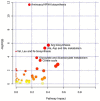Alteration in Plasma Metabolome in High-Fat Diet-Fed Monocyte Chemotactic Protein-1 Knockout Mice Bearing Pulmonary Metastases of Lewis Lung Carcinoma
- PMID: 35959507
- PMCID: PMC9358346
- DOI: 10.1177/11786388221111126
Alteration in Plasma Metabolome in High-Fat Diet-Fed Monocyte Chemotactic Protein-1 Knockout Mice Bearing Pulmonary Metastases of Lewis Lung Carcinoma
Abstract
Both clinical and laboratory studies have shown that monocyte chemotactic protein-1 (MCP-1) is involved in cancer spread. To understand the role of MCP-1 in metabolism in the presence of metastasis, we conducted an untargeted metabolomic analysis of primary metabolism on plasma collected from a study showing that MCP-1 deficiency reduces spontaneous metastasis of Lewis lung carcinoma (LLC) to the lungs in mice fed a high-fat diet (HFD). In a 2 × 2 design, wild-type (WT) or Mcp-1 knockout (Mcp-1 -/-) mice maintained on the AIN93G standard diet or HFD were subcutaneously injected with LLC cells to induce lung metastasis. We identified 87 metabolites for metabolomic analysis from this study. Amino acid metabolism was altered considerably in the presence of LLC metastases with the aminoacyl-tRNA biosynthesis pathways as the leading pathway altered. The HFD modified lipid and energy metabolism, evidenced by lower contents of arachidonic acid, cholesterol, and long-chain saturated fatty acids and higher contents of glucose and pyruvic acid in mice fed the HFD. These findings were supported by network analysis showing alterations in fatty acid synthesis and glycolysis/gluconeogenesis pathways between the 2 diets. Furthermore, elevations of the citrate cycle intermediates (citric acid, fumaric acid, isocitric acid, and succinic acid) and glyceric acid in Mcp-1 -/- mice, regardless of diet, suggest the involvement of MCP-1 in mitochondrial energy metabolism during LLC metastasis. The present study demonstrates that MCP-1 deficiency and the HFD altered plasma metabolome in mice bearing LLC metastases. These findings can be useful in understanding the impact of obesity on prevention and treatment of cancer metastasis.
Keywords: Lewis lung carcinoma; MCP-1; Metabolome; diet; metastasis; mice; plasma.
© The Author(s) 2022.
Conflict of interest statement
Declaration of conflicting interests: The author(s) declared no potential conflicts of interest with respect to the research, authorship, and/or publication of this article.
Figures




Similar articles
-
Metabolomes of Lewis lung carcinoma metastases and normal lung tissue from mice fed different diets.J Nutr Biochem. 2022 Sep;107:109051. doi: 10.1016/j.jnutbio.2022.109051. Epub 2022 May 21. J Nutr Biochem. 2022. PMID: 35609853
-
Metabolomic Alteration in Adipose Monocyte Chemotactic Protein-1 Deficient Mice Fed a High-Fat Diet.Nutr Metab Insights. 2024 Sep 28;17:11786388241280859. doi: 10.1177/11786388241280859. eCollection 2024. Nutr Metab Insights. 2024. PMID: 39372559 Free PMC article.
-
Monocyte chemotactic protein-1 deficiency reduces spontaneous metastasis of Lewis lung carcinoma in mice fed a high-fat diet.Oncotarget. 2016 Apr 26;7(17):24792-9. doi: 10.18632/oncotarget.8364. Oncotarget. 2016. PMID: 27028862 Free PMC article.
-
Metabolomic Alterations in Mammary Glands from Pubertal Mice Fed a High-Fat Diet.Nutr Metab Insights. 2023 Jan 31;16:11786388221148858. doi: 10.1177/11786388221148858. eCollection 2023. Nutr Metab Insights. 2023. PMID: 36744049 Free PMC article.
-
Monocyte chemotactic protein-1 deficiency attenuates and high-fat diet exacerbates bone loss in mice with Lewis lung carcinoma.Oncotarget. 2017 Apr 4;8(14):23303-23311. doi: 10.18632/oncotarget.15055. Oncotarget. 2017. PMID: 28177896 Free PMC article.
Cited by
-
Non-targeted metabolomics analysis of indoleamine 2,3-dioxygenase inhibitor treatment in a mouse model of early-stage lung adenocarcinoma.Transl Cancer Res. 2024 Feb 29;13(2):900-915. doi: 10.21037/tcr-23-1236. Epub 2024 Feb 26. Transl Cancer Res. 2024. PMID: 38482400 Free PMC article.
References
-
- Lebrecht A, Grimm C, Lantzsch T, et al.. Monocyte chemoattractant protein-1 serum levels in patients with breast cancer. Tumour Biol. 2004;25:14-17. - PubMed
-
- Lu Y, Cai Z, Galson DL, et al.. Monocyte chemotactic protein-1 (MCP-1) acts as a paracrine and autocrine factor for prostate cancer growth and invasion. Prostate. 2006;66:1311-1318. - PubMed
-
- Yoshidome H, Kohno H, Shida T, et al.. Significance of monocyte chemoattractant protein-1 in angiogenesis and survival in colorectal liver metastases. Int J Oncol. 2009;34:923-930. - PubMed
LinkOut - more resources
Full Text Sources
Research Materials
Miscellaneous

